 Billeter, National Rechenwalze, A.G. "System Billeter"
Billeter, National Rechenwalze, A.G. "System Billeter"
Originally: Julius Billeter Rechenwalze. Gallery includes specimen by son Ernest Billeter
Julius Billeter (1828 - 1914) made 'Rechenwalze' (Computing Rollers)
cylindrical slide rules for the financial industry based on Billeter's 1894 patent.
US Patent No. 513,172 January 23, 1894. French Patent No. 217,367 Nov. 10, 1891.
Most of the designs were marked as "System Billeter".
|
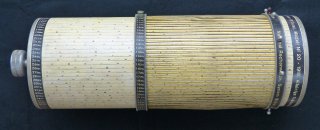
National Rechenweize "System Billeter"
Modell No 20 - 1918 Cylindrical Slide Rule
ISRM 13.03.15.01.X

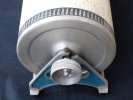


Carolina Radu, John And Walter |

John William Radu
(1879-1944) |

John William Radu with Crow
|
|
National Rechenweize System Billeter Modell No20 1918
Cylindrical Slide Rule (Computing Roller)
Made in Switzerland by National Rechenwalzen. Zurich, Switzerland. c1940,
Construction: Varnished paper scales on 20.5cm (8.12in) dia. x 57.3cm (22.5in) long metal cylinder and on
sliding cylindrical cage. Metal support stand.
Scale: 80 sections of C & D scales equivalent to 20 meters (65.6 ft) in length.
As part of the artifact, the wooden box is present that it was shipped in when it was sent from Zurich to New York City in 1940.

Robert A. Ecker
|
This specimen was acquired from Robert Ecker of Long Valley, New Jersey, who owned and preserved this excellent math instrument for 60 years. Robert graduated from Brown '55 (mechanical engineer, tau beta pi);
commissioned USAF, active duty Germany '57-'58 (missile guidance), reserve Capt. until '62 .
Employed by ExxonMobil '56-'85, (refinery ops, supply planning, tanker design).
Robert is a current ham radio operator (W2EKZ Amateur Extra),
Robert A. Ecker expanded Biography
|
Robert writes:
"It belonged to my grandfather, John William Radu (born 6/3/1879 in Poland or Romania, and died in
Manhattan 6/4/1944.. He lived in Rochester, NY where he graduated from the University of Rochester
and later moved to New York, NY. He was a many talented person designing and building medical
instruments for his own company and teaching at well known technical Stuyvesant High School in New York.
He built telescopes, collected minerals, conceived magic tricks for Howard Thurston, collected clocks
and music boxes, and must have been a very interesting person. I was only 11 when he died but remember
him showing me his collection of fluorescent minerals under a black light."
A record search shows that he attended U of R between 1903-1908 and that he had his own company, as General
Manager of Radu Surgical Instrument Co. during the same time from 1907-1911. Then he was superintendant
of the German Insurance Building, in Rochester, starting in 1911. In 1920 he was approved to be an
assistance teacher (Instrument making) for high schools and appointed to Stuyvesant (NY Times
Jan 30,1920).One can see why he liked this slide rule. More info on his career was in a donation to
UofR in 1947 in his name that shows a more detailed work history (see attached). There is a
reference that he married Clara Louise Coit who was an Alumnae class of 1897 Elmira College.
She was Robert Ecker's Mother's Mother.
|

REF Billeter Rechenwalze 4M Cylindrical Slide Rule
|
Billeter Rechenwalze 4M Cylindrical Slide Rule
Made in Switzerland by Julius Billeter. Zurich, Switzerland c1900,
Construction: Varnished paper scales on 5-cm dia. metal cylinder and on
metal vanes on a sliding cylindrical sleeve. Wood support stand
Scale: 20 rows of C & D scales equivalent to 4 meters in length
Note: This is an early example matching Billeter's 1894 patent.
Later examples carry "National Rechenwalze - System Billeter"
Archive - Ed Chamberlain Collection
|

REF National Rechenwalzen System Billeter Modell No8 Cylindrical Slide Rule
|
National Rechenwalzen System Billeter Modell No8 Cylindrical Slide Rule
Made in Switzerland by National Rechenwalzen. Zurich, Switzerland c1900,
Construction: Varnished paper scales on metal cylinder (8 cm dia. x 16 cm long)
and on metal vanes on a sliding cylindrical sleeve. Metal support stand.
Scale: 40 rows of C & D scales equivalent to 8 meters in length.
Note: Formerly Julius Billeter Rechenwalze. Frequently used by European banks and
accounting offices.
Archive - Ed Chamberlain Collection
|
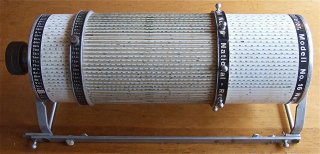
REF National Rechenwalzen System Billeter Modell No16 Cylindrical Slide Rule
|
National Rechenwalzen System Billeter Modell No16 Cylindrical Slide Rule
Made in Switzerland by National Rechenwalzen. Zurich, Switzerlan c1910,
Construction: Varnished paper scales on 16cm dia. x 36.5cm long metal cylinder and on metal vanes
on a sliding cylindrical sleeve. Metal support stand.
Scale: 80 rows of C & D scales equivalent to 16 meters in length.
Note: Formerly Julius Billeter Rechenwalze. This cylindrical slide rule has a metal
support stand that could be wall mounted. Frequently used by European banks and
accounting offices.
Archive - Ed Chamberlain Collection
|
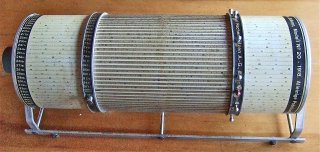
REF National Rechenwalze System Billeter Modell No20 1918 Cylindrical Slide Rule
|
National Rechenwalze System Billeter Modell No20 1918 Cylindrical Slide Rule
Made in Switzerland by National Rechenwalzen. Zurich, Switzerlan. Alleinige Fabrikanten, Switzerland c1920,
Construction: Varnished paper scales on 20.5cm dia. x 57cm long metal cylinder and on
sliding cylindrical cage. Metal support stand.
Scale: 80 sections of C & D scales equivalent to 20 meters in length.
Note: Formerly Julius Billeter Rechenwalze. This cylindrical slide rule has a metal
support stand that could be wall mounted. Commonly used by European banks for
currency trading. This is a previously unknown size. The largest previously known
National cylindrical slide rule had a 16-m scale length.
Archive - Ed Chamberlain Collection
|
 C.O. Browne, Melbourne, Australia C.O. Browne, Melbourne, Australia
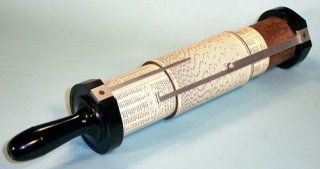
C.O. Browne Cylindrical "Long Scale Rule"
REF
|
C.O. Browne Cylindrical "Long Scale Rule"
Made in Australia by C.O. Browne. , No. F.C.46
Diameter 3", length 13" closed, 18" maximum
Similar construction to Fuller Cylindrical Slide Rules.
The single helical scale is marked on a cylinder about 2-3/4" in diameter and 4-1/2" long.
The scale makes 50 turns around the cylinder, for a total length of 413" (34 feet, or 10.5 metres).
It is marked to 4 significant figures at the top end, and can be read to 1 part in 20000.
The inner core of the rule is covered with tables of constants, formulae, and conversion factor
Scan provided by John Wolff. Australia
|
 Air Ministries Laboratory (AML) Bygrave
Air Ministries Laboratory (AML) Bygrave
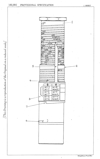
GB162895A
|
In 1920 Capt. Leonard Charles Bygrave of the Royal Air Force patented (GB162,865A) a slide rule design in which the scales formed helices wrapped around concentric telescoping
tubes. This allowed the scales to be made sufficiently long (nearly 8 meters) to obtain the required calculational accuracy. Bygrave's method for solving the navigational
triangle involves splitting it into two right triangles and applying Napier's rules. The required operations can then be reduced to a series of multiplications and divisions of
the trigonometric functions of the relevant angles. By suitable rearrangement these can all be written in terms of cosines and cotangents, or equivalently secants and
tangents, The Bygrave slide rule scales are the logarithms of these functions. Versions of the Bygrave slide rule were produced in Germany and Japan both for marine and
aerial use. In German versions, a mechanism that allowed the sliding scale tubes to be locked to together during calculations was introduced.
See "Bygrave Scales" by Robin G. Stuart, 2014 for making your own
Bygrave scales.
|
 Aristo Aristo

Aristo 3-Scale Drum Cylindrical Slide Rule
REF HSRC 32441
|
Aristo 3-Scale Drum Cylindrical Slide Rule
No Model number or description is known. Photo from an Aristo catalog documented by Herman van Herwijnen in his Slide Rule Catalogue "LITE". Reference the Dutch KRING.
|
 Dennert & Pape Höhenrechenschieber (pre Aristo) Dennert & Pape Höhenrechenschieber (pre Aristo)
|
This cylindrical calculating rule was designed to solve problems in spherical trigonometry encountered in navigation. For example, it could be used to compute the altitude and azimuth of a celestial body, knowing the latitude of the observer and the hour angle and declination of the body. Such a slide rule was patented by the Englishman Leonard C. Bygrave in 1921. This example, serial number 90143, was manufactured in Germany by Dennert and Pape at about the time of World War II. The instrument consists of three concentric cylinders. The innermost cylinder can be extended, and the outermost cylinder then slides up and down on part of the extended tube. Tightening a knob at the top fixes the relative position of the two inner cylinders. The innermost cylinder has a helical scale divided from 0 to 90 degrees (also from 180 down to 90). The middle cylinder has a helical scale marked from 0 to 90 and also from 145 to 90. At the bottom, the middle cylinder has instructions for using the instrument. The outermost cylinder has two marks for reading results, declination tables, formulas, and a window that allows for reading the second scale. The instrument fits in a cylindrical metal case painted black and lined with cloth near the top. Ref: Smithsonian National Museum of American History
|
 Bygrave (Japanese version) Bygrave (Japanese version)
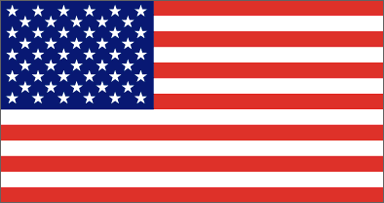
Keuffel & Esser
The 4012 and 4013 are cylindrical slide rules designed by Edwin Thacher in the late 1800s. It was patented in 1881. In 1891 K&E purchased the rights to the patent and began producing it.
The rule is a series of segmented B, C, & D scales arranged on a rotating cylinder. The 4012 is the basic rule. The 4013 is a 4012 with a magnifying glass mounted on it.
The rule was produced by K&E from 1891 to 1952. There were 3 variations in the construction methods over the life of the product:
Note: Thacher's spiral slide rules were rebranded by K& E Models Type I: 1740N, 1740, 1741 (1887-1900); Type II: 4012, N4012, 4013, N4013 (1900-1952) .
Type I ---- Model numbers 1740 and 1741 produced from 1891 to 1899.
Type II --- Model numbers 4012 and 4013 produced from 1900 to 1927.
Type III -- Model numbers N4012 and N4013 produced from 1927 to 1942. The N4012 continued on till 1952. Scale numbering was added to the end of the scales.
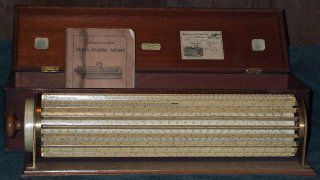
K&E 4012 Thacher's Calculating Instrument
REF
|
K&E 4012 Thacher's Calculating Instrument
Made in USA - Designed by Edwin Thacher
Archive - Michael O'Leary Collection (USA)
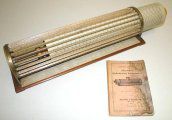
|

K&E 4105 Webb's Stadia Slide Rule
ISRM 24.07.04.27.X




|
K&E 4105 Webb's Stadia Slide Rule
Made in USA by Keuffel & Esser Co. N.Y. - Designed by Walter Loring Webb, C.E.
Scale on outer cylinder: 100-1000 (segment from 100 to 146.2 missing)
Scales on drum: Four Difference in Elevation, a single folded scale ranging from 1 minute to 40° labeled 1/10, 1/100,1/1000 and Three Horizintal Correction scales folded from under 2° up to 40°. labeled 1, 1/10, 1/100.
Tom Dilatush Collection
Walter Loring Webb (1863–1941), a civil engineer who graduated from Cornell University and taught there and at the University of Pennsylvania,.
Previously, Keuffel & Esser had introduced a 20-inch linear stadia slide rule in 1895. It sold under various model numbers (1749, 4101, N-4101) until 1952.
In 1897, the firm introduced a 50-inch linear stadia slide rule designed by Branch H. Colby of St. Louis. Colby's stadia slide rule (model number 1749-3,
later 4125) sold until 1903. Textbook authors such as John Butler Johnson endorsed the rule, but it was awkward to carry in the field.
Webb proposed an equivalent 50 inch rule that had parallel 13-3/8 inch long scales arranged on a 1-1/2 in diameter cylinder, reducing the overall
length of the instrument to about 16 inches. K∓E sold Webb's stadia slide rule for $5.00 from 1903 to 1923.
This instrument consists of a wooden cylinder covered with paper scales, wooden handles at the ends of the cylinder, and a metal sleeve lined with felt.
The sleeve, which is painted maroon, holds the cylinder. Running the length of the sleeve are a slot 1.5 cm wide and a paper scale.
Reference: National Museum of American History


1921 Catalog and Smithsonian Specimen showing left side of scale..
|
 Jean-Antoine Lafay, Loire, France. Jean-Antoine Lafay, Loire, France.

LaFay Hélice a Calcul Model 1 - 85cm Cylindrical Slide Rule 1930
ISRM 24.07.04.32
|
LaFay Hélice a Calcul Model 1 - 85cm Cylindrical Slide Rule 1930
Made in France by Jean-Antoine Lafay, Loire, France
Scale: 0.85M 50 revolution spiral scale on a cardstock tube.spiral scale on a cardboard cylinder 10 cm long & 2.7 cm diameter;.
in a transparent outer sleeve which provideds a hairline and two concentric rings.
Tom Dilatush Collection
|

LaFay Hélice a Calcul Model 2 - 250cm Cylindrical Slide Rule 1930
ISRM 24.07.04.33
|
LaFay Hélice a Calcul Model 2 - 250cm Cylindrical Slide Rule 1930
Made in France by Jean-Antoine Lafay, Loire, France
Scale: 2.5M 50 revolution spiral scale on a cardstock tube. spiral scale on a cardboard cylinder 19 cm long and 4 cm in diameter.
in a transparent outer sleeve which provideds a hairline and two concentric rings.
Tom Dilatush Collection
|
 Loga, Daemon-Schmid Loga, Daemon-Schmid

De Loga Calculators by Nico E. Smallenburg 2004 (924kb PDF)
|
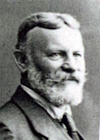
Heinrich Daemen-Schmid (18?? - 1930)
|
Heinrich Daemen-Schmid was the founder of theSwiss company Loga, famous for its straight, circular and cylindrical
slide rules. Heinrich emigrated from Germany to Zurich, Switzerland, and produced cylindrical slide rule calculators with the Loga Calculator company from 1900. Circular (Disks) and cylindrical (roller drum) slide rules were made by the company Billeter, Daemen-Schmid (Zurich, Switzerland), later renamed Loga (short for logarithm). Most of the cylindrical type were made in the 1930's and occupied a niche in the banking industry, while other manufacturers were making linear slide rules. The company stopped production soon after WWII.
Additional references:
Loga-Rechenwalzen By Herbert Bruderer of Zurich (PDF)
Loga Milestones Chapters by Herbert Bruderer of Zurich (PDF)
|
|
|
|


Loga (Daemen-Schmid) 1.2 meter cylindrical (Hand Model)
ISRM 24.07.04.10
|
Loga (Daemen-Schmid) 1.2 meter cylindrical (Hand Model)
Made in Switzerland by Daemon-Schmid c1900
20 individual 12.5cm long scales. 64mm diameter x 175mm long drum.
Gift of Debra Dilatush. Ted Dilatush collection


|
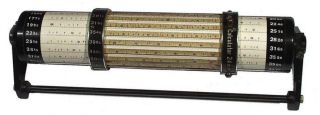
Loga (Daemen-Schmid) 2.5 meter cylindrical
REF
|
Daemen-Schmid (Loga) 2.5 meter cylindrical
Made in Switzerland by Daemon-Schmid c1930
Archive - Herman's Slide Rule Catalogue
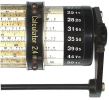
|
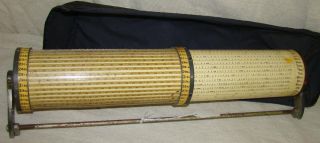
Loga (Daemen-Schmid) 7.5 meter cylindrical
ISRM (deaccessioned 11.15.2023)
|
Loga (Daemen-Schmid) 7.5 meter cylindrical
Made in Switzerland by Daemon-Schmid c1930
|

Loga (Daemen-Schmid) 7.5 meter cylindrical
REF
|
Daemen-Schmid (Loga) 7.5 meter cylindrical
Made in Switzerland by Daemon-Schmid c1930
Archive - Ed Chamberlain Collection
|
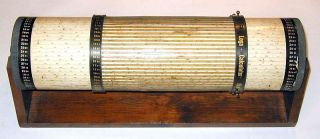
Loga Calculator (Daemen-Schmid) 15 meter cylindrical
REF
|
Loga Calculator (Daemen-Schmid) 15 meter cylindrical
Made in Switzerland by Daemon-Schmid
|
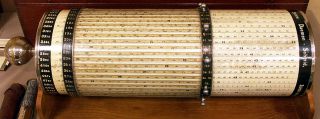
Daemen-Schmid (Loga) 24 meter cylindrical
REF
|
Daemen-Schmid (Loga) 24 meter cylindrical
Made in Switzerland by Daemon-Schmid 1915-1920
Paper faced aluminum drum
CD (100-1000) scales divided into 60 segments for a total length of 24 meter
Archive - Ed Chamberlain Collection
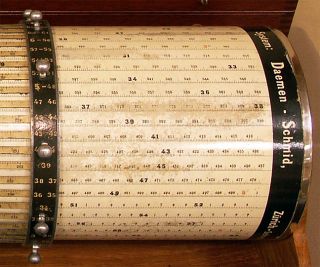
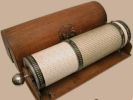 Galai Photo. Galai Photo.

|

Loga Slide Rule
REF
|
Loga Slide Rule
Made in Switzerland - Paper and metal backing
Front Scale:
Zz(K1), A [ B, R, C ] D, Zz(K2)
Back Scale:
A [ B, R ] C, Currency Conversions
Archive Herman van Herwijnen's Slide Rule Catalogue
|

Loga Pocket Slide Rule
REF
|
Loga Pocket Slide Rule
Made in Switzerland - Paper and metal backing
Front Scale:
K, A [ B, R, C ] D, Log
Back Scale:
A [ B, R ] C, Currency Conversions
Archive Herman van Herwijnen's Slide Rule Catalogue
|
 McFarlane, Glasgow, Scotland McFarlane, Glasgow, Scotland
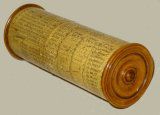
 McFarlane's 6 inch Calulating Cylinder (1835)
McFarlane's 6 inch Calulating Cylinder (1835)
REF
|
McFarlane's 6 inch Calulating Cylinder (1835)
Made by McFarlane, Glasgow, Scotland. Mid 19th century
McFarlane's Calculating Cylinder" (c. 1833), consisting of a cylinder with three
separate revolving parts, on which are inserted several series of numbers,
calculated to propose and answer questions to an almost indefinite extent in
the first four rules of arithmetic. Note that this device does not utilize logarithmic scales.
Made of paper covered turned mahogany, 6 3/8" long overall x 2 1/4" diameter, in 3 sections
plus 2 threaded end pieces. There are two columns on the top section, one column on the
center section, and three columns on the bottom section. The apparatus is designed facilitate
calculations in interest on English money. It is one of the earliest examples of a
handheld cylindrical calculating device.
Archive - Images from 2009 Phillip Wiess Auction, London Science Museum Collection, Gemmary,com
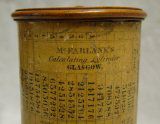

 1833 at NMSI.UK
1833 at NMSI.UK
|
 M. Niedermeier, Straubing M. Niedermeier, Straubing
|
|
|
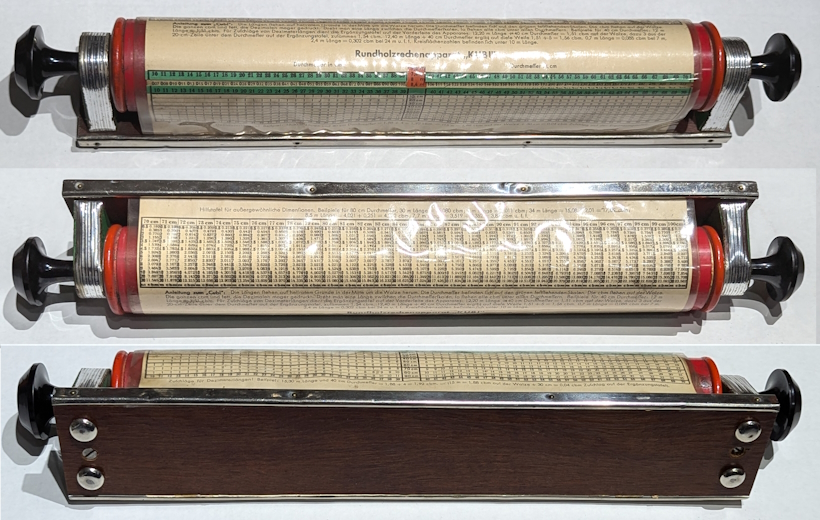
Rundholzrechenapparat "KUBI" Round Wood Calculator c1960
24.07.04.73.X



|
Rundholzrechenapparat "KUBI" Round Wood Calculator c1960
Made in Germany - Original design by Edmund Schneider (1888-1929)
43.7x6.5x7 cm; 0.51 kg. This is the more modern version of the "Cubis" made of plastic and wood.
Scale: Diameter, Length, Volume
The following reference is from: rechnen-ohne-strom.de
In 1908, Hermann Stoetzer wrote in Die Forsteinrichtung: Ein Lehr- und Handbuch (p. 86):
"The cubic table is replaced in a very practical way by the round wood calculator Cubus , which was designed and brought to the market by Eduard Schneider in Munich. It consists of a roller that rotates around a longitudinal axis and indicates the cubic contents in cubic meters and 2 decimal places for the various diameter levels, whereby the relevant length is found on the edge of a sleeve enclosing the roller and then the roller is rotated. This device saves the need to turn the pages in the cubic table and instead requires a simple rotation of the roller, which takes place very quickly."
In the textbook on wood measurement by Udo Müller, 1915, it says on p. 92f: " The Kubus roundwood calculator by Edmund Schneider is intended to save or make easier the search in the cubic table. ... When used, the measured log length is set to the slot by turning the cylinder and the content is read above the diameter number on the cylinder jacket. Without a doubt, the instrument makes the search in a table, which is very strenuous on the eyes, easier and can be highly recommended."
|
 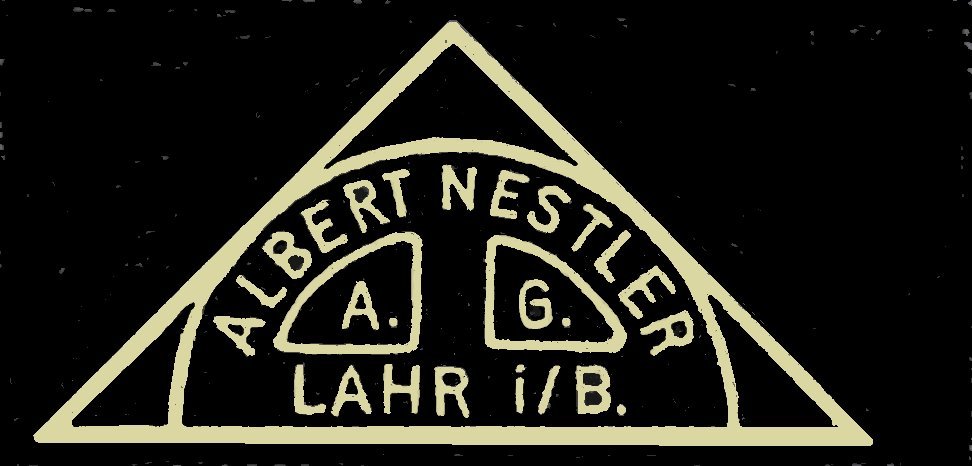


 Carbic Ltd., London Carbic Ltd., London
Cylindrical Pocket Slide Rule with Helical Scales
Scale effective length 66 in (168 cm) with 4 significant figures.
Otis Carter Formby King biography by Susan Richards

|
Known addresses of Carbic Ltd. (1921-1972):
0: 44 & 66 Bray's Lane, Coventry (1921)
A: "Ashdene," Emscote Road, Stoke, Coventry (1922)
1: 51 Holborn Viaduct, London, EC1 (c1940)
2: 137 Conway Road, London, N14
3: 171 Seymour Place, London, W1
4: 54 Dundonald Rd, London, SW19
(Addresses 0, 1, 3, and 4 are found
on instruction sheets or rules)
|
Patents
UK patent GB 183,723 (1921)
UK patent GB 207,762 (1922)
UK patent GB 207,856 (1922)
US patent US 1,645,009 (1923)
Canadian patent CA 241986
Canadian patent CA 241076
French patent FR569985
French patent FR576616
German patent DE 418814
|
Known Scale Sets: 409/410, 414/423, 416/417, 422/424, 429/430
Known Models: K, L, N.
 R.H. Smith R.H. Smith
 W.F. Stanley, Great Turnstile, Holborn, London W.F. Stanley, Great Turnstile, Holborn, London
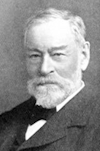
|
The company was founded in 1854 by William Ford Robinson Stanley (1829-1909). it became a limited company (corporation) in 1900. In 1861 Stanley invented a prize-winning straight-line dividing machine that was used to make accurate scales for slide rules and other mathematical instruments. Among the slide rules manufactured and distributed by the Stanley company were the C.T. Cooper slide rule and the Fuller spiral slide rule, designed by George Fuller in 1878. The H.O. Barnard's slide rule is from 1919. Included in Stanley's 1912 catalogue and continuing there until 1958 was Barnard's Coordinate calculator. It is very similar in construction to the Fuller instruments but its pointers have multiple indices so additional trigonometrical functions can be used. It cost slightly less than the Fuller-Bakewell and a 1919 example is held by the Science Museum, London. In 1962 the Whythe-Fuller complex number calculator was introduced. As well as being able to multiply and divide complex numbers it can convert between Cartesian and polar coordinates.
Note: Professor Fuller's spiral slide rules were rebranded by K& E Models 1742 (1887-1900) and 4015 (1900-1961).
|
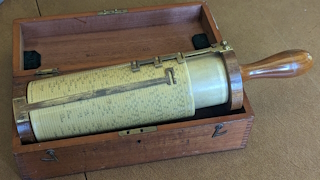
Barnard's Co-ordinate Spiral Slide Rule
ISRM 24.06.10.01
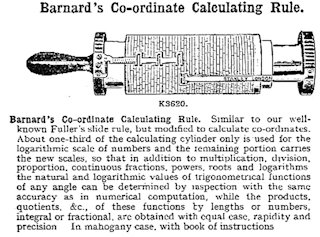

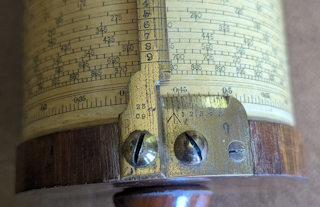
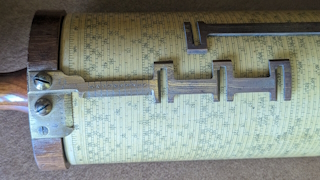
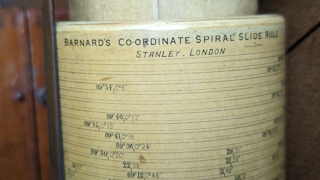
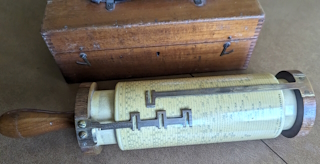
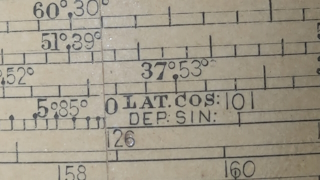
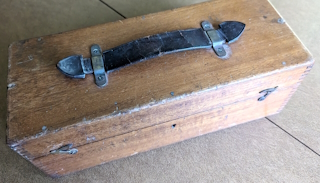
Note: the LAT COS (Latitude) and DEP SIN (Departure) scale labels.
|
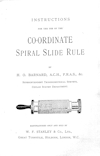 Barnard's Co-ordinate Spiral Slide Rule 1909 sn23
Barnard's Co-ordinate Spiral Slide Rule 1909 sn23
Made in United Kingdom Designed Henry (Henri) Osmand Barnard - (1869-1934). Geodesic engineer. M.S., A.C.H. and
Fellow of the Royal Astronomical Society. He was a Superintendent Trigonometrical Surveys, Ceylon (now Sri Lanka) Survey Department. Made by W.F. Stanley & Company See more of his biography in the SR Who's Who page
Description from 1914 catalogue: The Co- ordinate Spiral Slide Rule has been
designed to meet these requirements by Mr. H. O. Barnard, Like Professor Fuller's rule, upon which it is an improvement, it enables the user to perform
Barnard's co-ordinate spiral slide rule.with speed and accuracy arithmetical computations involving multiplication, division, proportion, continuous fractions,
powers, roots, and logarithms ; but in addition, the natural and logarithmic values of trigonometrical functions of any angle
can be determined by inspection with the same accuracy as in numerical computation, while the products, quotients, etc. , of
these functions, by lengths or numbers, integral or fractional, are obtained with equal ease, rapidity and precision . The scope
of its operations will be gathered from the examples which are given to illustrate its use in the instructions supplied with the rule.
Although the co-ordinate spiral rule, as all varieties of slide rules, is based primarily upon the theory of logarithms,
a knowledge of that theory is by no means essential to its practical use.
Original owner: Dr Garry J. Tee, (1933-18Feb2024), Professor Emeritus (1968) Department of Mathematics, University of Auckland, New Zealand.
Gift facilitated by the Powerhouse Museum, Sydney, Australia with permission from Dr. Tee.
 Prof. Dr Garry J. Tee, (1933-18Feb2024)(B.Sc. 1952, M.Sc. 1954). grew up during the 1930s Great Depression and in the South Island railway camps of that era.
After Garry Tee graduated from Auckland University College as M.Sc. (N.Z.), his first job was as a computer, with an oil prospecting team in
northwest Australia. In 1958, human computers began to be supplemented by electronic computers in geophysics, and it was obvious to him
that electronic computers were going to become extremely important. Accordingly, he went to England, where he became a mathematician in
English Electric Company, which manufactured DEUCE computers (based on Alan Turing's design for ACE). From 1964 to 1968 he was a
foundation member of the Department of Mathematics at the University of Lancaster, and then he returned to the Department of Mathematics
at the University of Auckland. He has published on numerical analysis and on the history of science, and he has translated books and papers on
numeric analysis from Russian to English. Full Obituary
Prof. Dr Garry J. Tee, (1933-18Feb2024)(B.Sc. 1952, M.Sc. 1954). grew up during the 1930s Great Depression and in the South Island railway camps of that era.
After Garry Tee graduated from Auckland University College as M.Sc. (N.Z.), his first job was as a computer, with an oil prospecting team in
northwest Australia. In 1958, human computers began to be supplemented by electronic computers in geophysics, and it was obvious to him
that electronic computers were going to become extremely important. Accordingly, he went to England, where he became a mathematician in
English Electric Company, which manufactured DEUCE computers (based on Alan Turing's design for ACE). From 1964 to 1968 he was a
foundation member of the Department of Mathematics at the University of Lancaster, and then he returned to the Department of Mathematics
at the University of Auckland. He has published on numerical analysis and on the history of science, and he has translated books and papers on
numeric analysis from Russian to English. Full Obituary
|
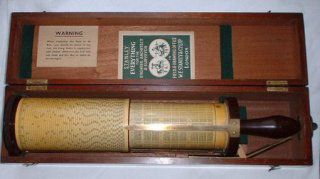
Professor Fuller's Calculating Slide Rule
ISRM 12.01.03.01.X


|
Professor Fuller's Calculating Slide Rule
Made in United Kingdom by W.F. Stanley & Company - Designed by Prof. George Fuller in 1878.
Original owner in UK
Description from 1912 catalogue: "Professor Fuller's Calculating Slide Scale, the most accurate od all calculating scales, is equal
to a straight slide rule 83 feet long, and gives logarithm, multiplication, division, proportion, etc., results in four or five figures. Its range is
greater than that of most arithetical machines, as besides the operationsof multiplication and division which many instruments can only
perform, results requiring the reciprocals, powers, roots or logarithms of numbers can be quickly and easily obtained by its use. Largely
used by civil, electrical, and mechanical engineers, actuaries, quantity surveyors, etc. In mahagonay case with instructions for use."
|
 Elizur Wright Arithmeter Elizur Wright Arithmeter
Made by Joseph W. Fowle, USA, 1869
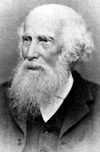
|
Elizur Wright III (1804-1885), born in South Canaan, Connecticut, was an American mathematician and abolitionist. He was a graduate of Yale College. He is sometimes described in the United States as "the father of life insurance", or "the father of insurance regulation", as he campaigned that life insurance companies must keep reserves and provide surrender values. Wright served as an insurance commissioner for the Commonwealth of Massachusetts. He devised a new formula and created actuarial tables to help insurance companies set premiums. finding the values of policies of various terms, known as the “accumulation formula,” and, in order to facilitate his work, invented and afterward patented (1869) the “arithmeter,” a mechanical contrivance for multiplication and division, based on the logarithmic principle, a form of cylindrical slide rule. U.S. Patent 93,849 issued August 17, 1869. wikipedia.
|
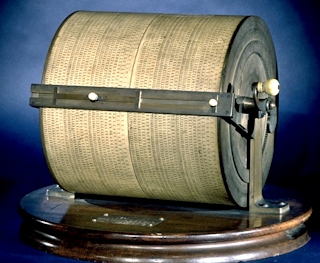 Wright's Arithmeter No. 8 Cylindrical Slide Rule
Wright's Arithmeter No. 8 Cylindrical Slide Rule
REF |
Wright's Arithmeter No. 8 Cylindrical Slide Rule
Made by Joseph W. Fowle, USA, 1869
Materials" Brass and wood. Paper scales on a brass drum.
Dimensions of Instrument: 36 cm x 48.2 cm x 48.2 cm; 14 3/16 in x 18 31/32 in x 18 31/32 in
Note: Wright sold the Arithmeter to insurance companies for $500.00, though only about 20 were made.
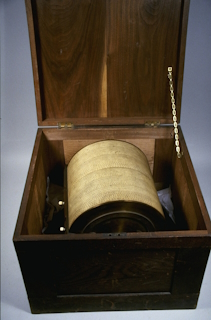
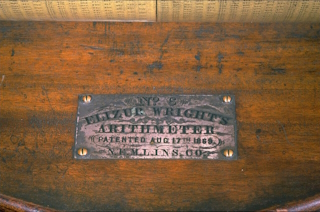
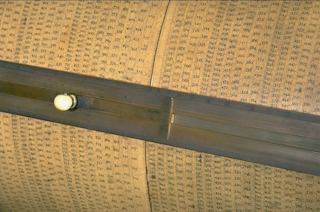
Archive - National Museum of American History
|
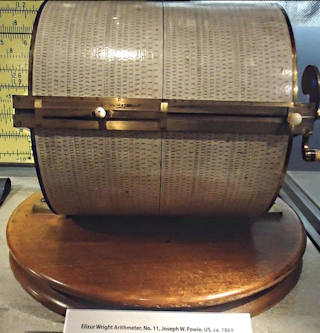 Wright's Arithmeter No.11 Cylindrical Slide Rule
Wright's Arithmeter No.11 Cylindrical Slide Rule
REF |
Wright's Arithmeter No.11 Cylindrical Slide Rule
Made by Joseph W. Fowle, USA, 1869
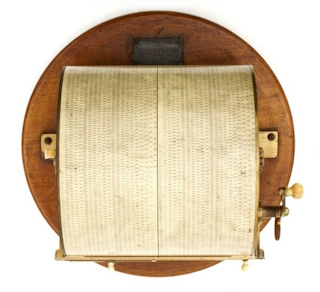
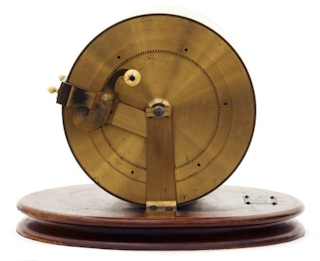
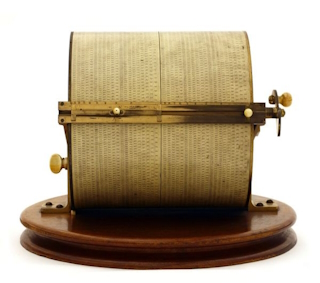
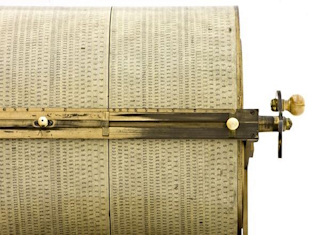
Archive - Computer History Museum in Mountain View, California
|
|

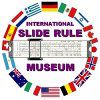







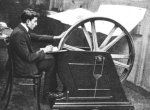














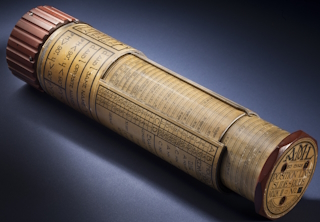


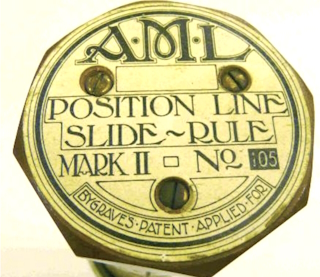
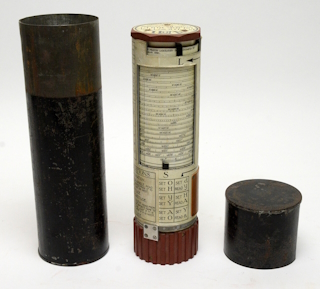
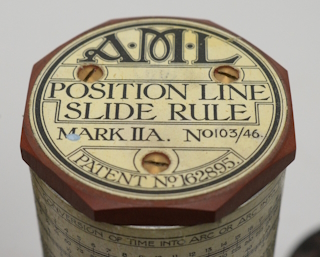
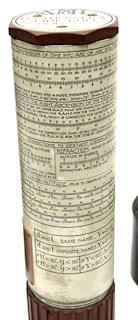
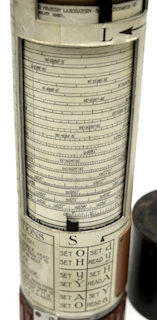







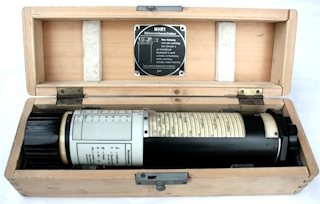
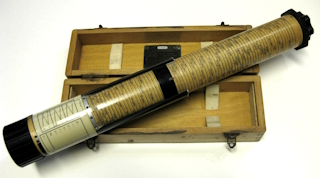
 Japanese WWII Navy Bygrave Position Line Slide Rule For Navigation
Japanese WWII Navy Bygrave Position Line Slide Rule For Navigation











































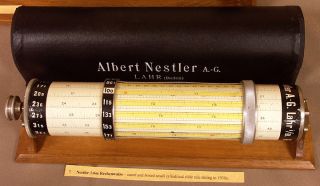
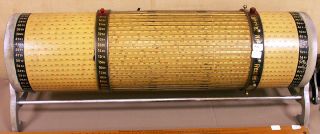

 Carbic Ltd., London
Carbic Ltd., London







 Leather Case
Leather Case


 Snap Case
Snap Case

 Leather Case
Leather Case

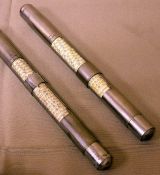















 Wright's Arithmeter No. 8 Cylindrical Slide Rule
Wright's Arithmeter No. 8 Cylindrical Slide Rule


 Wright's Arithmeter No.11 Cylindrical Slide Rule
Wright's Arithmeter No.11 Cylindrical Slide Rule


